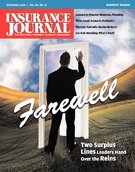Safe as houses.
That’s an expression I’ve never quite understood. In light of the catastrophic events of 2011, the phrase is especially confusing. How safe are houses – from wildfires, hurricanes, tornadoes, earthquakes, tsunamis and floods? If the conditions are just right, houses seem not to be very safe at all.
But they could be safer, experts tell us.
In Joplin, Mo., at least 159 people were killed, more than a thousand were injured, and many more were left homeless as a result of the tornado that blasted through a densely populated section of that city on May 22. It was the single deadliest tornado in the United States since modern record-keeping began in 1950, according to NOAA’s National Weather Service. Rated EF-5 on the Enhanced Fujita scale, the tornado cut a wide swath, traveling 22 miles on the ground. Insured losses are expected to reach at least $2 billion, the Missouri Department of Insurance reports.
In Alabama nearly a month earlier, a massive outbreak of tornadoes caused insured losses that may climb as high as $2.6 billion, according to the Alabama Department of Insurance. AIR Worldwide reported that around 5,000 structures were destroyed in Tuscaloosa alone after the EF-4 tornado churned through on April 27. More than half of those structures were homes.
Scientists from the University of Alabama acknowledge that nothing could have saved properties in the path of the storm’s center but say many buildings on the periphery could have survived with only a few minor changes in construction techniques. Likewise, researchers with the Institute for Business & Home Safety (IBHS) have long promoted the practice of strapping all the structural elements of a building together, whether it is a home or a commercial building, in order to better protect the property from the forces of nature.
In the aftermath of the wildfires that have destroyed lives, burned thousands of homes, and charred millions of acres in Texas this year, officials are urging people to remove dry brush and other flammable debris from around their homes. Such actions may not have helped residents of Bastrop County, where wildfires fueled by high winds and extreme drought conditions decimated more than 1,500 homes and left thousands homeless in September. But the Texas Forest Service says such protective measures will lessen the likelihood of the fire’s resurgence.
The IBHS, through its research efforts and its fortified building programs, is an important resource for those seeking ways to protect their properties from a variety of natural hazards. Credits on property insurance premiums are often available to those who build or retrofit their structures to fortified standards.
So, houses may not always be perfectly safe, but they can at least be safer.
Topics Catastrophe Wildfire Alabama
Was this article valuable?
Here are more articles you may enjoy.


 Supreme Court Overturns Chevron Rule in Blow to Regulators
Supreme Court Overturns Chevron Rule in Blow to Regulators  As Rates Rise, Majority of Homeowners Say Insurance Industry Is in Crisis: Survey
As Rates Rise, Majority of Homeowners Say Insurance Industry Is in Crisis: Survey  BlackSuit Cybercrime Gang Blamed in CDK Hack That Roiled Car Dealers
BlackSuit Cybercrime Gang Blamed in CDK Hack That Roiled Car Dealers  A $29 Billion Weed Market Fights to Diversify Amid Legal Hurdles
A $29 Billion Weed Market Fights to Diversify Amid Legal Hurdles 


